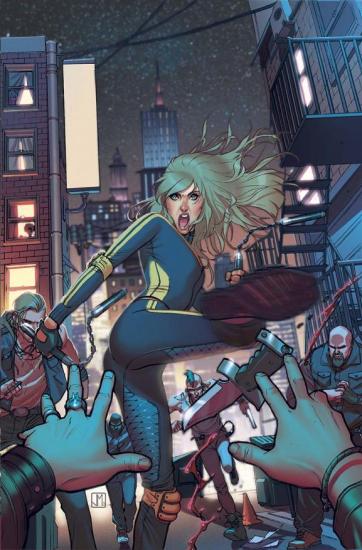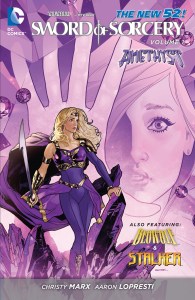The Mary Sue has interviewed writer Christy Marx before about her creation, Jem and the Holograms. But seeing as how she’s tackling some of our favorites at DC Comics these days, we felt like chatting again. Read on to hear what Marx had to say about the now-defunct Sword of Sorcery title, animation for girls, and what’s coming up in Birds of Prey!
Before you start, you might want to check out our special previews of DC Comics’ Sword of Sorcery Vol. 1 – Preview of character sketches, preview of Sword of Sorcery Vol. 1: Amethyst.
The Mary Sue: A lot of people probably know you from your animation work but can you tell us how you first got involved with DC Comics?
Christy Marx: The connection is through Dan DiDio. Before he went to work for DC, Dan was a development exec at ABC. I did a Saturday morning series for ABC that was a mix of live-action and CGI, called Hypernauts, and I worked closely with Dan on the development and production of the show. He was also familiar with my comic book work for Marvel.
We stayed in touch over the years and one day Dan called me out of the blue and asked whether I’d be interested in doing a reboot of Amethyst.
TMS: What was it like bringing the classic Amethyst series back to life? What was the best part? The biggest challenge?
CM: The biggest thrill and challenge both was find a way to do a fresh take on the series without repeating what had already been done, while at the same time trying to respect the original concept. I wanted to maintain that sense of surprise and destiny fulfilled by a girl who knew nothing about her background, and the intrigue of the gem houses. However, I felt that certain aspects needed to be updated in keeping with the kind of storytelling that’s going on in the female young adult market today.
The most fun for me overall was building out the characters, the world and the relationships. I love fantasy world-building.
TMS: When we posted a preview of the trade paperback for Sword of Sorcery, we had a lot of people praising the fully-covered and realistic armor the main character got to wear. Did you have a hand in that?
CM: I did campaign hard for more realistic clothing and armor. I was not willing to settle for a flimsy mini-skirt for a warrior woman. The design we arrived at is a nice compromise.
TMS: Were there any unfinished threads you wished you could have tied up or was there anything you would have done differently if you’d known it wasn’t going to continue past a certain issue?
CM: I had just enough advance warning to wrap up the final issues to the best of my ability. There were many threads I had hoped to spin out quite differently, especially the introductions of Preet/House Turquoise and the sons of House Diamond. I had long-term stories to set those up that had to be cast aside and everything compressed.
I began a thread with the Niyati the female Hunter and had no room to weave it into the final issues. I tried, but there simply wasn’t room for her.
I had many other threads for Houses Ruby, Emerald and Sapphire that I had hoped to get to later in the series.
TMS: Have you had a chance to watch all of the DC Nation Amethyst shorts? They focused a lot of video games, which I assumed might be something you’d get a kick out of.
CM: No, I haven’t seen any of them.
TMS: What do you think of the evolution of animated television for girls since you started there back in the 80s? From the Powerpuff Girls to My Little Pony: Friendship is Magic?
CM: I haven’t been following those shows. Powerpuff Girls didn’t appeal to me due to the art style. I’m picky about the look of animated shows. I’m not a MLP kind of person. I loved the original Avatar: The Last Air-Bender series and thought it was tremendously good. I had great hopes for the sequel with a female lead, The Legend of Korra, but sadly I didn’t find it as good or compelling. I can’t think of much out there right now that seems terribly promising for the girl audience, but I’m not following all of it as closely as I could be.
TMS: You’re currently the Senior Game Designer of Narrative Design at Zynga, a maker of social games. When statistics are brought up about how many women actually play video games, some find a way of saying many aren’t “real” gamers, for whatever that’s wording is worth, because they’re playing a mobile or Facebook game. What are your thoughts on that? The idea that those games don’t count for some, no matter how much money they make or players they may have.
[Editor’s Note (now edited for clarity): DC Comics did not return Marx’s answer to this question to us.]
TMS: We’ve also been hearing a lot of negative stories as of late about women working in the video game industry and the reactions they get from a disturbing segment of gamers. Do you ever receive criticism from strangers as a result of your gender? And if so, how do you handle it? And what do you think of these situations that seem to be popping up more often lately in the field?
CM: I don’t know whether it’s sheer dumb luck or what, but I haven’t encountered problems as a woman in the field of games as some other women have. I did once get some grief on a game team for being “intimidating”. LOL! Some men don’t know how to cope with strong, assertive women. Their loss. The thing is — and this is true in many areas of life — you have to pick your battles. Sometimes it’s better to simply shrug and move on. As the saying goes, “Don’t feed the energy beast.” Don’t pour your good energy down the maw of someone else’s bad energy. It’s better to starve a troll than feed it.

TMS: Looking ahead in your other DC title, Birds of Prey, what can we expect from the team? There’s been a lot of drama lately and I know you’re doing a Zero Year tie-in.
CM: You can expect a lot more emotional turmoil. I plan to keep putting these characters through the emotional wringer. A new benefactor comes into their lives and a classic DC villain comes along with that as well.
I just finished writing BoP #25 (a luxurious 28 pages), which is the Zero Year tie-in and it deals with the backstory of Dinah Drake — who she was then, how she came to be there, and how that event changes her life.
TMS: We often talk about which female comic book characters should make their jump to the big screen. Do you think the Birds of Prey would make a good film for today’s audience? Which female comic character are you hoping gets their own film soon?
CM: I’m afraid there aren’t a lot of singular female superheroes out there that have enough heft to carry a movie, given the tendency to turn superhero movies into mega-blockbusters. It would have been great to see what Joss Whedon could have done with Wonder Woman.
I don’t think BoP is best suited for film. Frankly, I’m a bigger fan of TV series and mini-series. You can accomplish so much more and take the time to explore your characters. TV is more of a writers’ medium than film, too. Game of Thrones is a prime example of a story that could only be told well in long form.
BoP did have a short life on TV once before; there’s no reason it couldn’t happen again with the right people behind it, though I do think it would need to morph into something a bit different to work in that format.
Here’s my pipe dream: someone comes to me with an offer to adapt Amethyst as a TV series — a mature live-action series in the vein of Buffy.
TMS: You’ve had a very successful writing career, any advice you’d give to readers hoping to follow a similar path?
CM: Making a career in a creative field is one of the most difficult things you can do. Being a writer, painter, illustrator, musician, composer — any of these takes complete dedication. You have to want it enough to overcome the most enormous obstacles including rejection and indifference toward your work. You need to develop a skin as thick as rhino hide and learn to separate criticism of your work from criticism of you personally. If you can’t make a living at it, be willing to do whatever it takes to support yourself while continuing to work at your craft.
Writing is partially about talent, but even more about learning your craft. You need to read voraciously and read a wide range of different types of material. You need to write and write, then rewrite a thousand times. You must learn to be merciless about your work until you get it right. And while this may sound simple, it’s crucial — you must be able to finish what you start. There are a ton of would-be writers out there who start and then give up. Anyone can have an idea. What counts is taking that idea and expressing it uniquely in a finished form, in your words and your “voice”.
Plug time: I’ve covered a lot of this advice and a lot of information about craft in my book: Writing for Animation, Comics and Games.
Are you following The Mary Sue on Twitter, Facebook, Tumblr, Pinterest, & Google +?








Published: Aug 27, 2013 02:46 pm